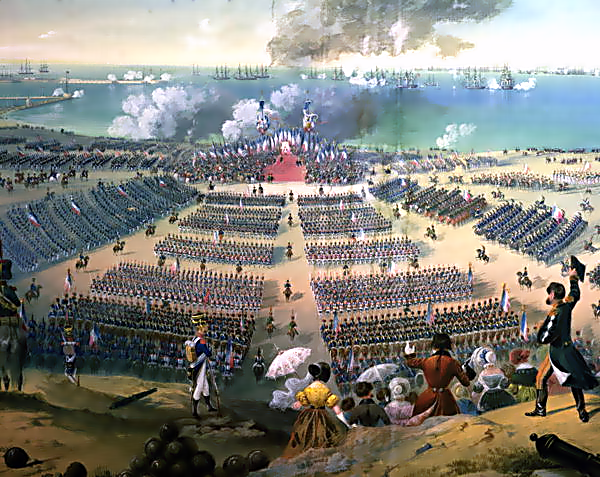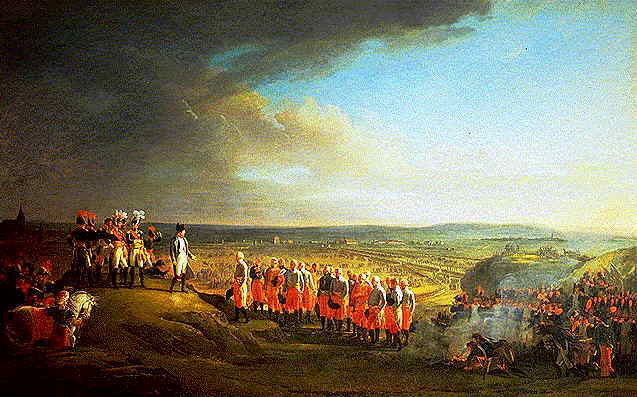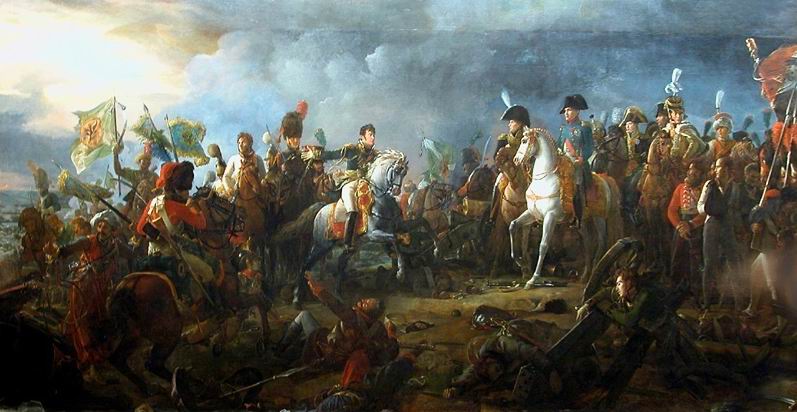| Austerlitz:
Battle of Three Emperors
By Bill Bodden
January 2016
In the two years prior to 1805, France had a substantial
portion of its armed forces camped on the Normandy coast preparing
for an invasion of England. In August 1805 the Emperor Napoleon,
having decided an invasion was impractical as long at British
seapower remained dominant, turned his back on England for
the time and marched instead toward continental Europe and
the threat posed by the Third Coalition.
Flush with cash from reparations owed France from the campaigns
of 1800, concluded by the Treaty of Amiens in late March 1802,
and also from the sale of the Louisiana Territory to the fledgling
United States, Napoleon gathered his forces and trained them
well. By 1805 Le Grand Armee was the best-trained army in
the world.
A series of diplomatic moves between France and England, namely
French embargoes placed on British shipping, led to a declaration
of war. Britain’s navy now blockaded French ports and
began to agitate against the French in Europe, forming an
alliance to oppose the armed might of the Emperor, still camped
inconveniently close just across the English Channel.

Le Grande Armee at Boulogne, August 1804
At the same time, rumors reached Napoleon’s ear of a
plot to restore the Bourbon family to the French throne. The
main subject of these rumors was the duke of Enghien, living
in exile in the neutral German state of Baden. Tired of years
of plotting against himself and his family, Napoleon ordered
the duke arrested, no matter that he was in another country
altogether. The duke was arrested and repatriated to France,
where he was tried, sentenced and executed. This was the final
straw as far as the other monarchs of Europe were concerned.
Seeing their own potential fate at the hands of Napoleon,
they all too eagerly agreed to Britain’s plan.
This Alliance, the Third Coalition, was struck between Austria,
Britain and Russia. Britain agreed to provide much of the
cash up front to finance the war, as long as Russia and Austria
came through with the manpower. The Third Coalition was an
uneasy alliance at best; neither the Russians nor the Austrians
completely trusted each other, being rivals in the Balkans
and Eastern Europe, and this suspicion led to a lack of co-operation
between the two empires at critical times.
Austria, still stinging from the loss of much of its Italian
territory to the French after the Treaty of Amiens, had been
reorganizing its armed forces. The Austrian Imperial Court
was constantly embroiled in scheming and shifting allegiances;
General Karl Mack was the darling of the faction that favored
war, and managed to convince the Austrian Emperor Franz that,
despite a military career where he was better known for being
a solid staff officer and administrator rather than field
commander, and his command of a disastrous campaign against
the French in Italy only five years previously where his own
troops turned on him, he was the one who could speed up military
reforms and have the army ready to meet Napoleon in only a
matter of months. Austria was also counting on support from
neighboring countries, including Bavaria, despite the latter’s
strong ties to France. These blindly optimistic ideas would
cost Austria dearly before the year was over.
General Mack's Army
General Mack set to work organizing the Austrian Army for
the coming campaign. In September 1805 he marched his army
north into Bavaria expecting the Bavarians to join him; instead,
having concluded a secret treaty with the French, the Bavarians
withdrew north and west to buy time for the French army to
arrive. Mack and the Austrians were dismayed, yet stayed in
a relatively forward position in Bavaria in the fortress-city
of Ulm, thinking themselves safe with a river between them
and Napoleon.
It is argued that one of Napoleon’s great strengths
as a military leader was his ability to move large masses
of troops much more quickly than expected. In this advance
he overran a number of smaller garrisons, meeting little resistance
from an Austrian army demoralized by Mack’s poor planning
and by their lack of adequate supplies, especially food. Bonaparte
drove his men hard, and their sweat and toil paid off when
they encircled Ulm and trapped roughly half of the entire
Austrian northern army inside the city.
Except for a few early skirmishes with the vanguard of the
French army, Mack had done little to keep himself informed
as to what was transpiring in the world outside Ulm, and the
French to caught him napping. Within Ulm the story was even
worse than it appeared. Surrounded and with little food and
less ammunition, the Austrians were in a very bad position
indeed. Their only hope lay in the speedy arrival of the Russian
army to break the siege and relieve them.
For their part, the Russians were doing the best they possibly
could. Three Russian armies were on the march; General Benningson’s
northern army marched across Prussia and into Austria near
present-day Prague; General Kutusov, the overall commander
of the Russian forces, marched straight through Austria; General
Buxhowden’s army brought up the rear, positioned partway
between the line of march of the other two forces so he could
come to the aid of either Benningson or Kutusov if needed.
Having been on the move since August — setting off barely
two weeks after Austria officially joined the Third Coalition
— the Russians had covered hundreds of miles but were
still many miles away. Winter was approaching, and the autumn
rains were turning every road into a river of thick mud. Despite
the army being largely on foot, progress was good, but the
clock was ticking away on the Austrians trapped inside the
walls of Ulm. By October 16 the Russians had covered over
600 miles but were still 160 miles away from Ulm —
at least ten days’ march if the weather was good, and
they would need a few days after arriving to regroup and organize
themselves once they arrived. In the end, it was two weeks
before they would reach the vicinity of Ulm; by then it was
too late.
General Mack, despairing of Russian salvation from the French,
surrendered the entire army bottled up in Ulm, more than 25,000
men, as prisoners of war. General Jellacic’s column,
another 8,000 Austrian troops, surrendered in the Tyrol valley
in Austria, to the south of Mack’s position. General
Werneck’s column to the north also surrendered. More
than three-quarters of the northern Austrian army was already
out of the way; those that were left (some cavalry had escaped
capture at Ulm, and General Kienmayer’s eastern column
was largely untouched) retreated east to join up with the
advancing Russians. On October 25, 1805, only two weeks after
initial contact with the French, the grand battle plan of
the Third Coalition was in tatters.
Now Napoleon turned his attention to the approaching Russians.
Archduke Charles, sent to keep a large part of Napoleon’s
army busy in northern Italy at the outset of hostilities (and
to keep him out of the way of General Mack, whom Charles considered
unfit for command), marched north after a modest victory against
the French at Caldiero in Italy with some 30,000 men, hoping
to link up with the remnants of the northern army and the
Russians. The going was slow, and his troops were in poor
shape. Still, Charles did himself and Austria no favors by
resting his troops for two whole days while the French closed
in on the Austrian capital of Vienna.
On his way to Vienna after being released on parole by the
French, the unfortunate General Mack informed the Russians
of what had happened, then proceeded to the Austrian capital
and his eventual court-martial. After receiving the news of
the disaster at Ulm, Kutusov began to retreat from Napoleon,
buying time for the rest of Russia’s armies to unite,
and looking for good ground on which to challenge the French
emperor.
Napoleon had his army swing north, sweeping through Vienna
in an effort to have his easternmost divisions swing around
behind the Russians, virtually encircling them. The French
were aided in this pursuit by the Austrians themselves, who
treated Napoleon more like a conquering hero than a hated
enemy, even allowing French troops free and unimpeded access
to bridges that could have been destroyed to slow his progress.
The Austrians, it seems, were more afraid of their plundering
allies than of the French. The Russians were behaving as if
in enemy territory, looting as they passed.
The Russians continued to fall back, spending all of November
skirmishing with the French and looking for a good position
while waiting for the full strength of all three armies to
converge. The remnants of the northern Austrian Army had linked
up, and soon it began to turn for the showdown to come. On
December 2, 1805, more than 140,000 men would contest the
Moravian ground near the town of Austerlitz while the whole
of Europe held its collective breath.

General Mack surrenders at Ulm. By Charles Thevenin.
Posturing and Negotiations
Napoleon had secretly scouted the area around Austerlitz some
weeks earlier, and had chosen the area as the perfect place
to spring his trap on the unsuspecting Allies. The Allies
thought themselves in a quite good position as well, and had
things gone as planned they may have been correct.
To the north, the Prussian government was watching developments
with interest. Napoleon had offered Prussia the city-state
of Hanover in exchange for Prussia’s neutrality in the
conflict. Prussia had not officially accepted yet, and had
secretly decided to join the Allies against the French after
the end of 1805. Meanwhile, the Prussians watched and waited.
The Russian army was nominally under the overall command
of Mikhail Kutusov, an able but cautious commander with over
40 years’ military experience leading troops into
battle. In reality, Tsar Alexander, who had joined the army
once it had reached close proximity with the enemy, was truly
in charge. The Tsar, perfectly capable of drilling troops
expertly but with no real combat command experience, was heavily
influenced by a faction in the Russian Imperial Court who
favored aggressive action. These fire-eaters, convinced that
glory was a superior consideration to any other, convinced
the Tsar to ignore Kutusov’s sound but drab battle plan,
much to the detriment of the Allies’ chances for victory.
On November 29, French cavalry evacuated a small plateau,
called the Pratzeberg Heights, which they had been holding
east of the village of Austerlitz. It was a calculated move
on Napoleon’s part, and the Allies took the bait, occupying
those same heights in force only a few hours later. Napoleon
sent a trusted aide to the Allies encampment under a flag
of truce. He was to make opening overtures toward a cease-fire,
by his very presence suggesting that the French were not prepared
for battle. Secretly he was there to gather information.
It was painfully apparent that the Allied high command not
only lacked unity but was filled with outright dissent. Russian
Prince Dolgoruky returned with the aide to the French field
headquarters and began to make demands of Napoleon himself
as conditions for peace. Napoleon, meanwhile, made sure that
the prince would see only what the French emperor had wanted
him to see. When the meeting concluded he was even more confident
that his plan was working perfectly. After seeing only cavalry
around Napoleon’s camp, Prince Dolgoruky returned with
news that the French were not only unprepared for battle,
they were withdrawing.
Having tricked the Allies into consuming an entire day with
fruitless negotiations, Napoleon had purchased sufficient
time for his army to form up where he needed them, and for
his outlying divisions to make their way to the battle site.
On the morning of December 2, the Allies started forward,
convinced they would be pursuing the French army as it retreated.
Having spent the night in freezing cold, they were ready for
a fight. They immediately discovered their error as several
French infantry divisions met them and held firm.
As the battle of Austerlitz began in earnest, the majority
of the battlefield was shrouded with a thick fog. In the center
of the French line stood Marshal Soult’s IV Corps, some
22,000 men in total. His Corps hidden in a deep depression
by the fog, Soult’s advance towards the Pratzeberg Heights
at 9 A.M. was a shock that nearly unnerved the Allies forces.

Bataille d'Austerlitz, by François Pascal
Simon Gérard.
Rout from the Heights
On the Allies’ extreme left, the Austrian infantry had
begun to advance, probing the French positions. After a brief
initial success they were thrown back by the timely arrival
of several battalions’ worth of French infantry, beginning
a see-saw struggle for tactically important structures at
the south end of the battlefield. Napoleon was presenting
his forces in strength on the Allies’ right, appearing
to leave his own right weak and vulnerable.
The Allies were convinced by this showing, and began to concentrate
a large portion of their troops from the center to the south,
hoping to break through the weak left and sweep these broken
forces north, encircling the entire French army. Unknown to
the Allies, Marshal Davout had come up from the southwest
with a fraction of the III Corps, some 4,000 infantry and
cavalry, as an advance force to bolster the supposedly weak
French left.
In the north, marshals Murat and Lannes were trusted with
keeping the Allied Fifth Column pinned down. With the exodus
of the troops from the center to assault the French right
to the south, General Bagration’s column was virtually
isolated. Lannes sent two regents forward to begin the encirclement,
but they ran into stubborn resistance from a small group of
Russian infantry. This resistance bought enough time for Bagration
to extricate himself, but not before a tremendous artillery
exchange, and a running duel between of the Russian Imperial
Guard cavalry and Murat’s cavalry reserve.
In the center, Soult’s massive Corps now began an advance
up the Pratzeburg Heights, filling the gap left by the Allies’
move against the French right. This advance by Soult was intended
to split the Allied forces in half, and would provide the
French the opportunity to overwhelm the Allies piece by piece,
starting with the northernmost wing and rolling south along
the plateau.
Marshal Bernadotte had arrived during the night with his
I Corps, and was held in reserve in the rear of the French
lines; his troops were hidden from the Allies’ view
behind a line of hills along with several battalions of French
grenadiers.
In panic the Allies sent forces to reinforce the Pratzeburg
Heights, but to little avail; Napoleon’s forces had
driven off most of the force left there held against the reinforcements
until Bernadotte’s corps and the grenadiers were sent
to help. The battle was turning into a rout. Emperors Francis
of Austria and Alexander of Russia both quit the field.
The French moved to the south of the heights, in a perfect
position to bombard those troops of the Allies that had so
recently enjoyed that same view. Attempting to escape the
encircling French army, the First and Second Columns of the
Allies found themselves in a tight spot; due to French pursuit,
they had a large portion of their retreat rout blocked by
a frozen lake. As the troops began to cross the ice, French
bombardment followed, further panicking the retreating troops
and driving them into the frozen lake in droves. The ice was
not thick enough to support the weight of all those men, horses
and artillery pieces. It gave way. A few hundred men sank
to a frigid, watery grave. Many others scrambled to shore,
but in their terror and confusion many wound up prisoners
of war, and very few artillery pieces crossed the ice unscathed.
Napoleon had achieved what is arguably his most brilliant
victory.
In the aftermath of Austerlitz, the Russians retreated back
across the frontier to their homeland, leaving the Austrians
and French to sort things out. Austrian Emperor Francis applied
to Napoleon for an armistice, and before the end of the month
had signed the Treaty of Pressburg, ceding significant portions
of the once-proud Holy Roman Empire to French control. These
lands would be used to form the Confederation of the Rhine,
a series of small, sovereign Germanic States loyal to Napoleon,
acting as a buffer zone to separate the French from Prussia
and Austria. These nations and city-states would contribute
significant forces to Napoleon’s future war efforts,
even fighting with the French during the Russian Campaign
of 1812.
The Austerlitz Campaign could not have gone better for the
French, while the Allies were left with the felling that they
couldn’t do anything right. A large indemnity would
hamper the Austrian economy for years to come and keep the
French coffers well-stocked.
With the struggle over so quickly, Prussia, which had planned
to enter the war on the Allies’ side after the first
of the year, decided instead to accept Napoleon’s offer
of the city of Hanover and related territories in exchange
for their neutrality. Now Britain was alone in opposing the
ambitious Bonaparte — although rumblings from Prussia
in 1806 would lead to another decisive campaign, and the humbling
of another great European power.
Don’t wait to put Soldier Emperor on your game table! Join the Gold Club and find out how to get it before anyone else!
|
